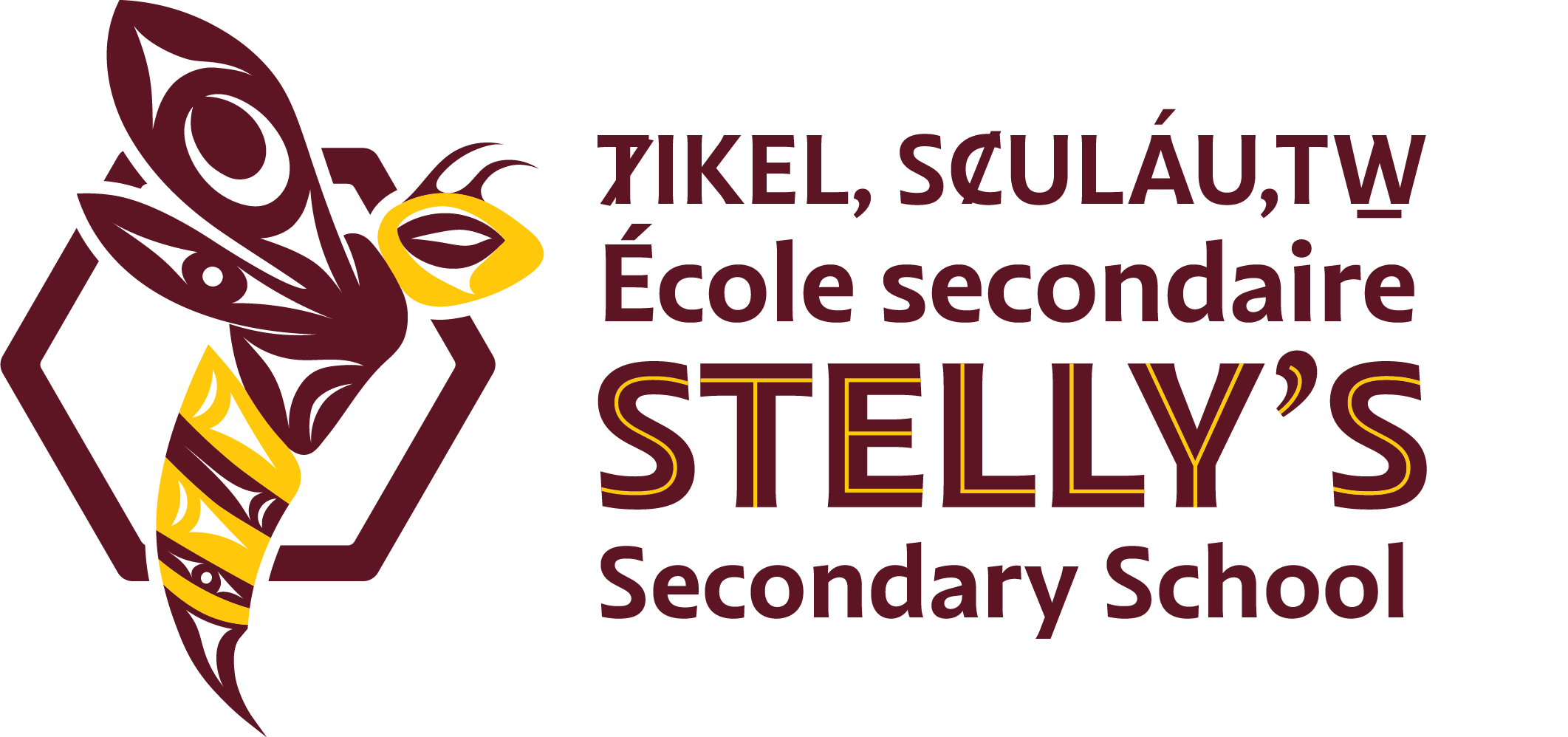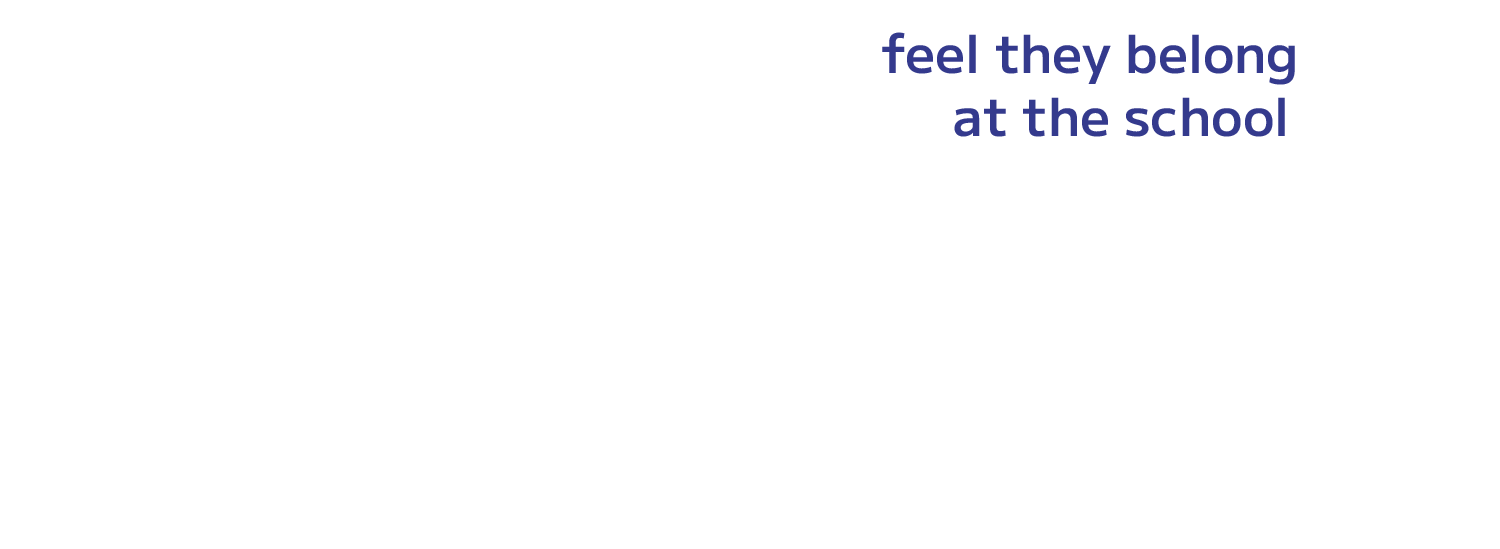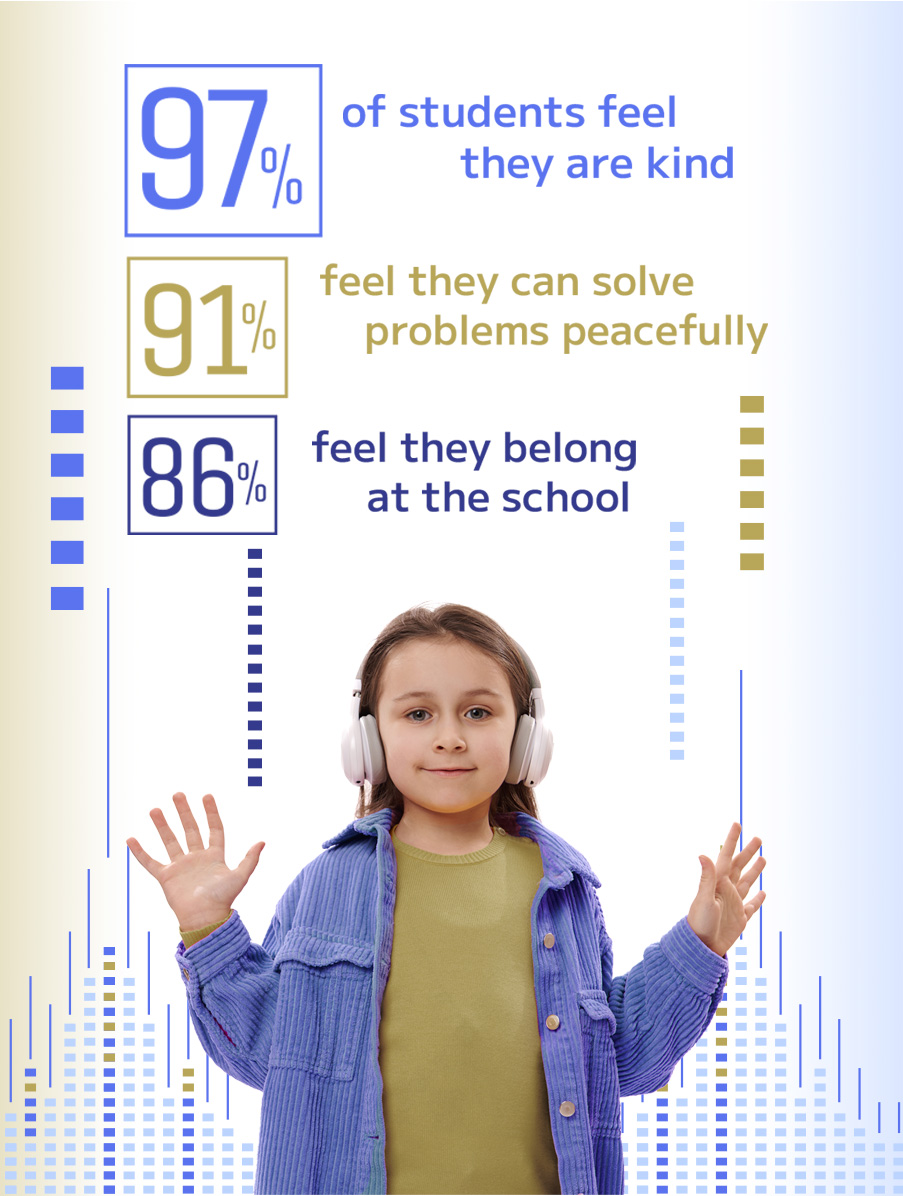School Goal One
Given the relationship between long-term success and social emotional wellness, we will look to provide opportunities for students to understand, advocate for, and manage their wellness through a school wide, strength-based program.
If students have the strategies and support to positively affect their social & emotional well-being, will we see an increase in attendance, engagement, completion, and self-reports of positive well-being?
What Do we Know About ALL Learners:
Students with strong social-emotional skills including positive mental health is a prediction of long-term life outcomes such as stable employment, graduation from high school, completion of post-secondary and improved mental wellness in adulthood (Dr. Kimberly Schonert-Reichl, UBC Education, 2020). Establishing inclusive, caring, respectful, and safe learning environments plays a vital role in enhancing the mental health and well-being of students, staff, and families. Positive mental health is sense of emotional well-being that respects the importance of culture, equity, social justice, interconnections and personal dignity (Public Health Agency of Canada). Prioritizing positive mental health and Social Emotional Learning (SEL) cultivates learning environments that embrace and uplift all students. In inclusive, caring, respectful and safe learning environments:
- Positive and healthy relationships are nurtured.
- School staff collaborate with community partners to ensure students' safety and well-being.
- Students feel cared for by adults, both collectively and individually.
- Clear, consistent, and regularly communicated expectations are set for academics and behavior.
- Strategies for mental health promotion and social-emotional learning are woven into classroom instruction and school-wide activities.
- Comprehensive support is extended to students affected by inappropriate behavior and those engaged in such conduct.
- Students demonstrating unacceptable behavior receive fair and appropriate consequences, accompanied by supportive measures.
What Do We Know About ALL INDIGENOUS Learners?
Recognizing the unique circumstances, challenges, and opportunities faced by Indigenous peoples and communities, we acknowledge that many mental health challenges encountered by these populations are deeply rooted in historical and intergenerational trauma, socio-economic disparities, and discrimination stemming from the detrimental effects of residential schools and day schools. The resulting impacts extend to the mental health, well-being, and socio-economic, as well as educational outcomes of Indigenous students. There is an urgent need for collective action and accountability to address the profound harm inflicted on Indigenous peoples by Canada.
At Stelly's, our core belief is that, given appropriate support and opportunities, all learners can attain success. The key to learner success lies in fostering a culturally safe, compassionate, and inclusive learning community that actively cultivates strong relationships among every member of our school community, including students, staff, and families.
What Do We Know About OUR Learners?
Provincially, there has been a decline in the self-reporting of positive mental health. While the 2018 McCreary Centre Society survey showed 73% of grade 10-12 students across the province rated their mental health as good or excellent, the most recent (2024) Stelly’s Student Learning Survey data revealed that only 56% of students in grade 10 –12 rate their mental health as “Excellent”, “Very Good” or “Good”. Equally concerning is that this same survey found that only 37% of grade 10-12 students agreed with the statement, “At school, I am learning how to care for my mental health” (only 27% for grade 12 students) and only 37% agreed the statement, “I am satisfied that in school I learn how to express emotion and deal with problems that I may face in the future”.
Our student learning survey results, and our anecdotal evidence collected from focus groups and individual empathy interviews at Stelly’s show a need for SEL programming.
being a significant contributing factor. Additionally, we regularly have students referred to outside agencies such as Integrated Mobile Crisis Response Team (IMCRT), Discovery, Child & Youth Mental Health (CYMH), Indigenous Child and Youth Mental Health (ICYMH) and outside counsellors above the significant utilization of Stelly’s counsellors.
Positive mental health and overall well-being of students, staff and families is the keystone to learner success. SEL is an integral part of student mental health and wellness that can cultivate protective factors against mental health risks. Within a culturally safe, respectful, and inclusive learning community, the prevalence SEL education can provide the foundation for ALL learners to be successful.
This goal and our focused inquiry questions align directly to our district’s strategic priority in Mental Health and Wellness. Additionally, our intended approaches are deeply connected to the First Peoples Principles of Learning.
Self Reported Positive Mental Health Grades 10 & 12
Stelly's Student Surveys - Collective Data
First Peoples Principles of Learning

The Social Emotional Wellness Goal needs to ensure that:
- Learning ultimately supports the well-being of the self, the family, the community, the land, the spirits and the ancestors.
- Learning is holistic, reflexive, reflective, experiential, and relational (focused on connectedness, on reciprocal relationships, and a sense of place).
- Learning recognizes the role of Indigenous knowledge.
- Learning requires exploration of one’s identity.
- Learning involves recognizing that some knowledge is sacred and only shared with permission and/or in certain situations.
In discussing all the components of social emotional healthy schools, we can consider the Tier 1 aspects that are outlined in School Mental Health Ontario’s “Aligned & Integrated Model (AIM)”.
Welcome – Social & Physical Environments. At Stelly’s, we:
- Spend the first week of each new semester focusing on classroom culture and relationships within our classrooms.
- Have increased the number of social tables in common areas around the school for students to sit at during break and lunch
- Have Mug-up every Friday to foster staff relationships and connections.
Include – Student Engagement & Belonging. At Stelly’s:
- We offer a Social Leadership class that organizes and runs fun events for the student body (ie, School Spirit Assemblies, Friday Fun Days, Spirit Weeks, Fill-the-Hive Food Drive, Kindness Drive for holiday hampers)
- We host numerous clubs and teams that provide a space of belonging for many students (ie, GSA club, BIPOC club, Social Justice Club, Culture Club, Book Club, Gardening Club, Paddling Club, Model United Nations Club, Dungeons & Dragons Club, Textile Arts Club, Chess Club).
- We have moved the Cultural Room to the front of the school to mark its presence and importance in our school.
- We spend extra time and resources focusing on a positive transition into high school with grade 8 visits for a day in May/June, offer a TRAILS program for a selection few that might need an extended transition period, student summer tours in August, student leadership phone calls to welcome new students to Stelly’s, have just grade 9s on the first day back in September, and have staff (ISTs, counsellors, admin) do transition meetings with their Bayside counterparts to discuss students who might need additional support.
Understand – Mental Health Literacy & Knowing your Students. At Stelly’s
- We are in year two of a systems approach to SEL. We have appointed a Wellness Team (including the expenditure of a block of teacher staffing time) who are tasked with organizing and running a series of four Wellness Days per year. On these Wellness Days, all students participate in a series of presentations on topics (see below) that are designed to promote mental health awareness and resilience. Feedback collected from students after each session is used to refine our offerings for the following year.
Grade 9 - Building Resilience and Health Bondaries
| Online Harassment | Managing Stress, Anxiety and Grief | How to Support Struggling Friends | Cannabis Use and Impacts |
Grade 10 - Making Informd Choices for Personal Safety and Wellbeing
| Gratitude Changes Everything | Consent and Abusive Relationships | Addiction adn Substane (mis)Use | Gangs and Recruitment |
Grade 11 - Navigating Life's Challenges: Health, Resilience, and Global Awareness
| Sexual Health | Trafficking Pornography, and addiction | Turning Welness Data into Real Change | Ecological Grief and Climate Anxiety |
Grade 12 - Empowering Future-Ready Citizens
| Finances for the Future | Community Supports for Substance Use and Addiction | Violence is Preventable | Traumatic Brain Injury: Impact and Prevention |
- In our October & November staff meetings each year, we complete a Relationship Mapping activity with theentire staff to identify which grade 9 (or new to Stelly’s) students might not yet have a positive staff relationship and then we undergo a process to foster these connections. We also come back to this list at the beginning of the next school year to determine which students, as grade 10s, do not have a positive staff connection.
Promote – Curriculum, Teaching & Learning. At Stelly’s:
- Our Physical & Health Education (PHE) teachers as well as our Career ife Education (CLE) 10 and Career Life Connections (CLC) teachers continue to provide learning opportunities around the health and well-being components of the curriculum.
- We employ three counsellors (1.5 FTE) and a full-time Youth and Family Counsellor (YFC) who work collaboratively to support our student body.
Partner – Home, School, Community Partnerships. At Stelly’s:
- We continue to have a Welcome Back BBQ at the beginning of each year to invite parents and students into the school, and are looking for other opportunities to invite parents and community members into our building.
- We ask teachers to reserve three Parent-Teacher Interview time slots for families of vulnerable students, and provide staff meeting time to make phone calls to invite in these families.
- We hold a rotating course selection evening in one of our four Indigenous communities to assist families with the course selection process and graduation planning. We are looking at ways to continue to provide these opportunities for low-barrier connections between the school and local communities.
- We have developed a long-term partnership with Human Nature Counselling that works with a small group of students each year to use nature and relationship-building to connect these students to staff members at our school.
Over the 2025-26 year, we will track progress on our initiatives identified in this year's plan, specifically we will continue with:
- Wellness Days (Year 2) – run four Wellness Days for all students. We would also like to find a way to better track students’ connection to wellness topics, and look at engaging parents in some wellness topics (through virtual and in-person parent sessions).
- Class profile meetings - bi-annual review of academic and SEL strengths and stretches with Inclusion support team (IST, counselor, admin, ELS, SLP, Psychologist, Literacy intervention) to guide term-to-term interventions in the area of SEL and support using the 3 tiers of intervention model and track and adjust over the year;
- Report card tracking: data from the previous school year and the current year will be tracked to identify areas where students might need additional support;
- Teacher observations - increase in student awareness of applying strategies, increase academic readiness, increase motivation, increase resilience and perseverance; and
- Student Voice (district sessions, survey feedback, leadership camp examine students’ mental health baseline and establish strategies which might help students improve wellness skills and resilience.
- Examine student attendance data (directly or through student survey) to see if there is any correlation between missed learning time and students who report wellness challenges.
By the end of this school year, Stelly’s grade 10-12 students will have had eight wellness sessions in total (while the grade 9s will have had four sessions). With a program that is designed to expose students to 16 different topics over the course of four years, it is hard to know when identifiable results will emerge, but we are hoping that we will start to gather anecdotal evidence (e.g. empathy interviews) and summary evidence (e.g. survey data) that suggests that students are gaining tools and strategies that are helping them deal with the wellness challenges faced by young people. By exposing parents to some of these same topics, we are hopeful that the learning will not stop at the school’s front door, and that students and their families will start a wellness feedback loop that reinforces the learning and improves wellness at both school and at home.
We are also hopeful that a more concerted effort around minimizing cell phone use in class and increasing student accountability around missed learning time will have positive effects on wellness for students (and staff).











